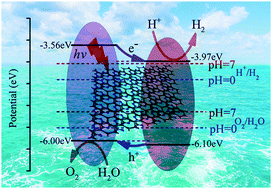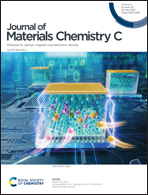The In2SeS/g-C3N4 heterostructure: a new two-dimensional material for photocatalytic water splitting†
Abstract
In this work, the structural, electronic and optical properties of the In2SeS/g-C3N4 heterostructure are investigated to explore a highly efficient and spontaneous water splitting photocatalyst by first-principles calculations. The results show that the In2SeS/g-C3N4 heterostructure with a bandgap (Eg) of 2.03 eV is a typical type II semiconductor, which guarantees that the generated electrons and holes can be effectively separated. The potential of the conduction band minimum (CBM) and the valence band maximum (VBM) satisfies the requirements for photocatalytic water splitting. Meanwhile, the In2SeS/g-C3N4 heterostructure has a strong light-absorption ability, and mainly absorbs purple and blue light. In addition, the changes of Gibbs free energy (ΔG) are calculated to understand the oxygen evolution reaction (OER) process of water splitting. Under neutral conditions (pH = 7), the Gibbs free energy continuously decreases during the OER process, verifying the thermodynamic feasibility of water splitting through the In2SeS/g-C3N4 heterostructure. Hence, the In2SeS/g-C3N4 heterostructure is a kind of photocatalyst with excellent performance in the area of photocatalytic water splitting.

- This article is part of the themed collection: 2020 Journal of Materials Chemistry C most popular articles


 Please wait while we load your content...
Please wait while we load your content...